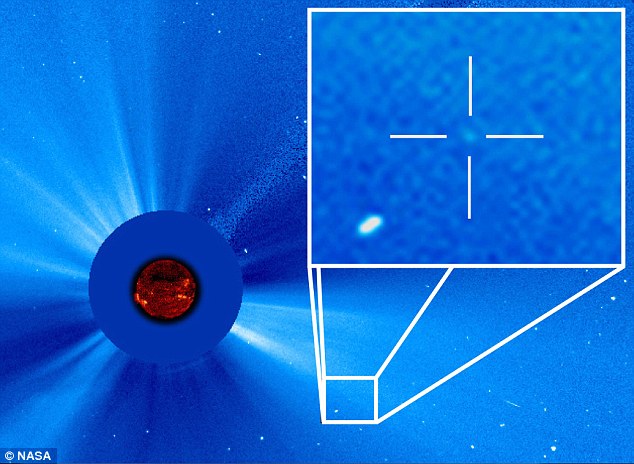
These include 'sungrazers' which pass within 850,000 miles (1.38million km) of the sun's surface, often shattering or evaporating in its heat.
Comment: It's not the 'heat' that does that; it's the electric stress.
This week, Soho confirmed it had discovered its 3,000th comet of this kind and captured its final moments before it was said to have been destroyed by our star's epic energy field.
Although spotted using Soho images, this milestone was actually achieved by keen stargazer Worachate Boonplod, from Samut Songkhram, Thailand.
'I am very happy to be part of a great milestone for Soho's comet project,' he said.
Before it was launched by Nasa and the European Space Agency (Esa) in 1995, only a dozen or so comets had been discovered from space, compared to around 900 from Earth.
The observatory has since given astronomers a glimpse of many of these so-called 'dirty snowball' comets in their final moments, with some captured seemingly making a death dive into the sun.
Three new families of comets have been found thanks to the Soho mission.
Comment: 'Families', such a cute term suggesting that they know and understand comets inside-out! All it basically means is that comets tend to come from certain directions.
The observatory's mission is to observe the sun and interplanetary space above Earth's atmosphere that blocks so much of the sun's radiation.
From there, Soho watches the solar disk and its surrounding environment, tracking the constant outward flow of particles known as the solar wind, as well as giant explosions of escaping gas called coronal mass ejections, or CMEs.
In its two decades in orbit, Soho has opened up a new era of solar observations, dramatically extending our understanding of the star we live with.
The telescope's comet prowess, however, was unplanned and has turned out to be an unexpected benefit.
It can easily spot sungrazers approaching the sun, because of its clear view of our star's surroundings.
Joe Gurman, mission scientist for Soho at Nasa's Goddard Space Flight Centre in Greenbelt, Maryland explained: 'Soho has a view of about 12-and-a-half million miles beyond the sun.
'So we expected it might from time to time see a bright comet near the sun. But nobody dreamed we'd approach 200 a year.'
The telescope's success as a comet finder is due to amateur astronomers sifting through the vast sea of data which is publicly available online in near real-time.
While scientists often search Soho imagery for very specific events, various members of the astronomy community choose to comb through all the imagery in fine detail.
The result is that 95 per cent of Soho comets have been found by these citizen scientists.
Karl Battams, a solar scientist at the Naval Research Laboratory in Washington DC, who has run the Soho comet-sighting website since 2003, said: 'The people who have found comets represent a very broad cross section as the program is open to anyone who has interest.
'There are scientists, teachers, writers. We have even had two 13-year-olds.'
Comets are of interest to astronomers because they reveal a lot about the place and time where they originated.
They are composed of frozen gases mixed with dust, giving them the nickname 'dirty snowball', and hold clues about the formation of our solar system.
If they have made previous trips around the sun, they can hold information about the distant reaches of the solar system through which they've travelled.
Sungrazing comets also help experts learn more about our sun.
Their tails of ionized gas illuminate magnetic fields around the sun, so they can act as a tracer that helps scientists observe these invisible fields.
Such fields have even ripped off comet tails allowing astronomers to watch the lost tails blowing in the steady outpouring of solar particles streaming off our closest star.
The tails act as giant 'windsocks' in this solar wind, showing researchers the details of the wind's movement.



I looked at the the original article. They use the word 'dirty snowball' to descibe what a sungrazing comet is. And they are "small":
"Sungrazers can be as small as 30 to 150 feet ( 9 to 46 metres) in diameter and most don't survive the trip around the sun." For comparison the Chelyabinsk meteroite was about 17 meters and it was not a dirty snowball!
About dirty snowballs they say: "Around 80 per cent of comets captured by Soho travel along the Kreutz path, which is a single orbit taking 800 years to complete.
Known as Kreutz comets, they are fragments of one large comet that broke up thousands of years ago."
If we are to believe that all these dirty snowballs originated from a large comet then this original comet must have been a super, super large dirty snowball?!?
Could it be that the dirty snowball analogy is a way of "breaking it gently" and "cooling down" our anxieties?